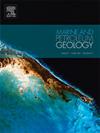Mineralogy and geochemistry of some trace fossils filled or lined with fecal pellets from the Cenozoic of the Northern Apennines and the Tunisian Atlas
IF 3.6
2区 地球科学
Q1 GEOSCIENCES, MULTIDISCIPLINARY
引用次数: 0
Abstract
Fossil burrows containing fecal pellets, Tubulichnium mediterraneum (Zouza Member, Tunisia) and Alcyonidiopsis isp., along with the hosting silty marl (Pagliaro Formation, Italy), were examined to interpret their mineralization. Various mineralogical techniques were applied. Siderite is the primary mineral phase of the fillings. Their zonation reflects progressive diagenetic alterations moving inward from the surface, with the extent of alteration varying across different samples and locations. A model for the burrow mineralization and its alterations is proposed, outlining for the first time a complete sequence of mineralization events. Initially, burrows were filled with fecal pellets and mineral particles derived from the surrounding sediment. Siderite formed under more reducing conditions in relation to the host rock due to the decomposition of organic matter, i.e., mucus and fecal pellets. The δ13C values in siderite (−10.3 to −8.5 ‰PDB), indicates formation in a suboxic zone through a process analogous to dissimilatory bacterial iron reduction (DIRB) in sediments, influenced by bacterial sulphate reduction (BSR) and possibly calcite transformation. The δ18O data suggest formation from marine pore fluids, possibly with biological influence. Mildly alkaline and oxidizing fluids led to the siderite surface alterations, forming goethite rims. Continued dissolution of the cores of siderite-goethite grains resulted in hollow goethite grains. Cavities formed by siderite leaching, or cracks formed due to physical weathering, were filled with Mn-Fe oxyhydroxides. The latest stage involved formation of a thin goethite layer on the sample's surfaces.
来自北亚平宁和突尼斯阿特拉斯的新生代的一些带有粪便颗粒填充或内衬的微量化石的矿物学和地球化学
含有粪便颗粒的化石洞穴,地中海微管(突尼斯Zouza成员)和Alcyonidiopsis isp。,以及寄主粉质泥灰岩(意大利Pagliaro组)进行了检查,以解释它们的成矿作用。应用了各种矿物学技术。菱铁矿是充填物的主要矿物相。它们的分带反映了从地表向内移动的渐进式成岩蚀变,不同样品和地点的蚀变程度不同。提出了洞穴成矿及其蚀变模型,首次勾勒出完整的成矿事件序列。最初,洞穴里填满了粪便颗粒和来自周围沉积物的矿物颗粒。由于有机质(即黏液和粪便颗粒)的分解,相对于寄主岩石,菱铁矿在更多的还原条件下形成。菱铁矿的δ13C值(- 10.3 ~ - 8.5‰PDB)表明其形成过程类似于沉积物中的异同化细菌铁还原(DIRB)过程,可能受到细菌硫酸盐还原(BSR)和方解石转化的影响。δ18O数据表明其形成于海相孔隙流体,可能受生物影响。轻度碱性和氧化性流体导致菱铁矿表面变化,形成针铁矿边缘。菱铁矿针铁矿颗粒芯的持续溶蚀形成空心针铁矿颗粒。由菱铁矿浸出形成的空洞,或由于物理风化形成的裂缝,被Mn-Fe氧氢氧化物填充。最新阶段是在样品表面形成一层薄薄的针铁矿层。
本文章由计算机程序翻译,如有差异,请以英文原文为准。
求助全文
约1分钟内获得全文
求助全文
来源期刊

Marine and Petroleum Geology
地学-地球科学综合
CiteScore
8.80
自引率
14.30%
发文量
475
审稿时长
63 days
期刊介绍:
Marine and Petroleum Geology is the pre-eminent international forum for the exchange of multidisciplinary concepts, interpretations and techniques for all concerned with marine and petroleum geology in industry, government and academia. Rapid bimonthly publication allows early communications of papers or short communications to the geoscience community.
Marine and Petroleum Geology is essential reading for geologists, geophysicists and explorationists in industry, government and academia working in the following areas: marine geology; basin analysis and evaluation; organic geochemistry; reserve/resource estimation; seismic stratigraphy; thermal models of basic evolution; sedimentary geology; continental margins; geophysical interpretation; structural geology/tectonics; formation evaluation techniques; well logging.
 求助内容:
求助内容: 应助结果提醒方式:
应助结果提醒方式:


